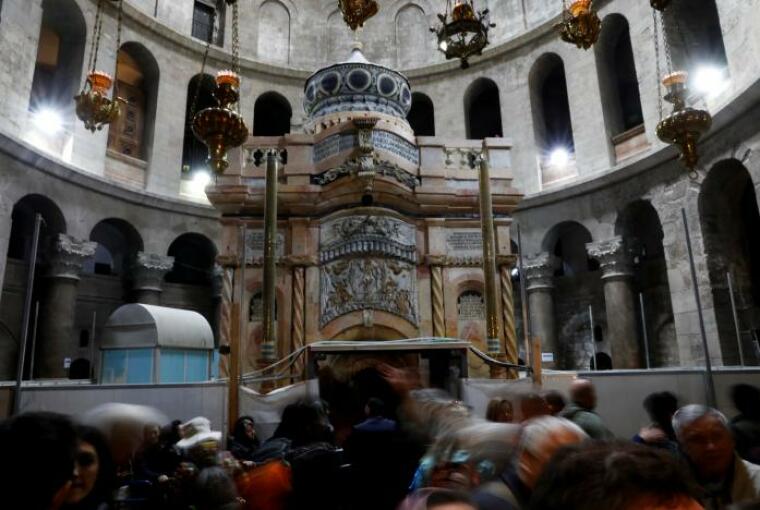Jesus' burial shrine reopens following nine-month restoration work

The purported site of Jesus' tomb is slated to be reopened to the public this week after a team of restorers and scientist completed the renovation of the Edicule, a shrine that is believed to house the cave where Jesus was entombed and resurrected.
The Edicule, located at the Church of the Holy Sepulchre, needed reinforcement and conservation, including the installation of an underground drainage network for rainwater and sewage, according to Antonia Moropoulou, who directed the restoration work at the site.
The restorers have removed the iron cage built around the shrine by British authorities in 1947 in order to shore up the walls, according to The Associated Press. The team also cleared the black soot that accumulated on the shrine's stone facade from decades of pilgrims lighting candles.
Moropoulou, a professor at the National Technical University of Athens, said that extensive work has been done on the tomb's masonry, and titanim bolts have been inserted into the stone slabs, including the one covering the tomb.
The custody of the church is shared by The Greek Orthodox, Armenian and Roman Catholic denominations, who have held up the restoration work on the site for over 200 years because of interdenominational disputes. The restoration only started last year when the church was deemed unsafe by Israeli authorities.
"If this intervention hadn't happened now, there is a very great risk that there could have been a collapse. This is a complete transformation of the monument," said Bonnie Burnham of the World Monuments Fund.
The tomb was exposed for the first time in October last year when the scientists removed the marble cladding that covered it since at least 1555 A.D. The tomb was identified as a relic in 326 A.D. by Helena, the mother of the Roman Emperor Constantine.
Fredrik Hiebert, archaeologist-in-residence at the National Geographic Society, said at that time that the scientists were surprised by the amount of material beneath the marble covering.
"It will be a long scientific analysis, but we will finally be able to see the original rock surface on which, according to tradition, the body of Christ was laid," he added.
Each denomination made contributions to the project, which cost around $3.3 million. Jordan's King Abdullah also made a personal donation for the restoration of the site, according to media reports.
 Christians don't have to affirm transgenderism, but they can’t express that view at work: tribunal
Christians don't have to affirm transgenderism, but they can’t express that view at work: tribunal Archaeology discovery: Medieval Christian prayer beads found on Holy Island
Archaeology discovery: Medieval Christian prayer beads found on Holy Island Presbyterian Church in America votes to leave National Association of Evangelicals
Presbyterian Church in America votes to leave National Association of Evangelicals Over 50 killed in 'vile and satanic' attack at Nigerian church on Pentecost Sunday
Over 50 killed in 'vile and satanic' attack at Nigerian church on Pentecost Sunday Ukrainian Orthodox Church severs ties with Moscow over Patriarch Kirill's support for Putin's war
Ukrainian Orthodox Church severs ties with Moscow over Patriarch Kirill's support for Putin's war Islamic State kills 20 Nigerian Christians as revenge for US airstrike
Islamic State kills 20 Nigerian Christians as revenge for US airstrike Man who served 33 years in prison for murder leads inmates to Christ
Man who served 33 years in prison for murder leads inmates to Christ


 Nigerian student beaten to death, body burned over ‘blasphemous’ WhatsApp message
Nigerian student beaten to death, body burned over ‘blasphemous’ WhatsApp message 'A new low': World reacts after Hong Kong arrests 90-year-old Cardinal Joseph Zen
'A new low': World reacts after Hong Kong arrests 90-year-old Cardinal Joseph Zen Iran sentences Christian man to 10 years in prison for hosting house church worship gathering
Iran sentences Christian man to 10 years in prison for hosting house church worship gathering French Guyana: Pastor shot dead, church set on fire after meeting delegation of Evangelicals
French Guyana: Pastor shot dead, church set on fire after meeting delegation of Evangelicals ‘Talking Jesus’ report finds only 6% of UK adults identify as practicing Christians
‘Talking Jesus’ report finds only 6% of UK adults identify as practicing Christians Mission Eurasia ministry center blown up in Ukraine, hundreds of Bibles destroyed: 'God will provide'
Mission Eurasia ministry center blown up in Ukraine, hundreds of Bibles destroyed: 'God will provide' Church holds service for first time after ISIS desecrated it 8 years ago
Church holds service for first time after ISIS desecrated it 8 years ago Burger King apologizes for 'offensive campaign' using Jesus' words at the Last Supper
Burger King apologizes for 'offensive campaign' using Jesus' words at the Last Supper Uganda: Muslims abduct teacher, burn him inside mosque for praying in Christ’s name
Uganda: Muslims abduct teacher, burn him inside mosque for praying in Christ’s name